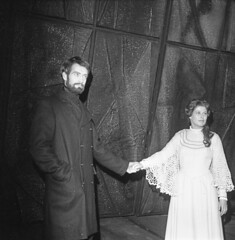 Kino
Kino
Mainly thanks to the Norwegian actress Liv Ullman and the Swedish director Ingmar Bergman, the first great success of Norwegian cinematography was the screen version of the book Sigrid Undset Krystyna, Lavran's daughter, based on the first volume of a tragedy in medieval Norway. One of the three Norwegian Nobel laureates in Literature has become the most interesting author for filmmakers adapting literature, Knut Hamsun. Three of his novels have been transferred to the screen: Hunger, Pan oraz Telegrafista. Two films by other creators, The case against Hamsun and a three-hour biographical film about the writer's life, testify to the fascination with the controversial author, who supported Hitler during World War II.
A film about the present day, Babette's Feast, awarded with an Oscar, also has a Norwegian connection. The action of the novel, which author Karen Blixen placed in Northern Norway, was transferred by director Gabriel Axel to Danish Jutland, where the landscape is flatter. On the other hand, the film by the Russian director Nikita Michalkov, Black Eyes, was filmed among the picturesque landscapes near Kjer-ring0y in Nordland.
Nils Gaup's film The Pathfinder was nominated for an Oscar. The plot is based on a medieval legend, and the dialogues were written in the Sami language. It was so well received, that Disney Corporation has invested in the next Gaup movie, Hakon Hakonsson, about Norwegian Robinson Crusoe, who set off for the southern seas in the last century. The film Nine Lives was also nominated for an Oscar, prolific director Arne Skouen, Dagbladet newspaper columnist, which in years 1948-1968 he shot 17 movies. The painting shows the history of the German occupation. The protagonist is a soldier washed ashore on the stormy northern coast of Norway, trying to reach neutral Sweden.
There are also films for children in Norwegian cinematography. Erik Gustavson directed a children's comedy called Herman, about a 10-year-old boy from Oslo, who has hair problems. Marius Holst shot in 1995 r. Heavenly Angel, which won an award at the Berlin Film Festival. This work also presents childhood conflicts, a takes place in Oslo. The painting by Frida Berit Nesheim deals with the problems of adolescence. Eva Isaksen has made several films in the Pelle and Proffen series, telling about the adventures of two teenage detectives. Ivo Caprino, specializing in animated films and Norwegian fairy tales, created the fun animated film Pinchcliff Grand Prix.
The problems of Norwegian women are best presented in Anja Breien's work, who started her career in the middle of the years 70. the film of Jostedalsrip, depicting the story of a young girl from the 14th century., which is the only survivor of the plague in a valley in western Norway. Over the next 20 years Breien created the film trilogy of Wives, Wives 10 years later and Wives III. The protagonists of the films are three women, who come to the school reunion and talk about their lives. Fourth part, announced for a year 2005, is to continue the topic of women's problems, this time entering the next millennium. Breien's most famous films are Nearest Relatives, shown at the Cannes festival in 1979 r., and the Witch Hunt, awarded at the festival in Venice St. 1982 r.
One of the most famous international film audiences about Norway is the rather banal Song of Norway, popularized biographical treatise on the life and work of Edvard and Nina Grieg. It is true that the landscapes and music are monumental here, but the film was made more with its potential entertainment value in mind than with historical truth.
